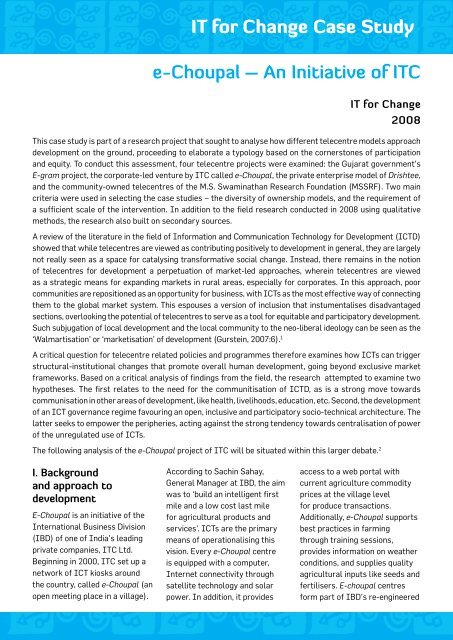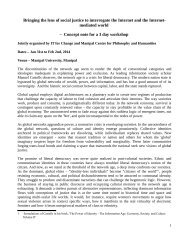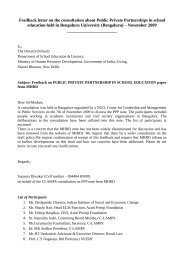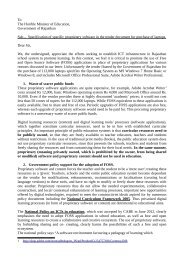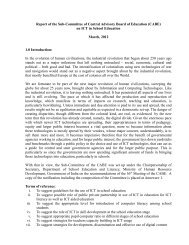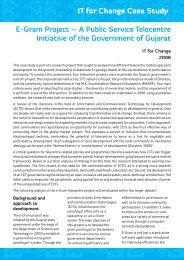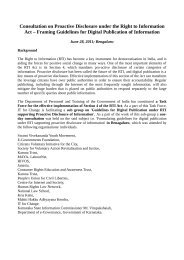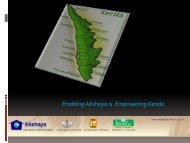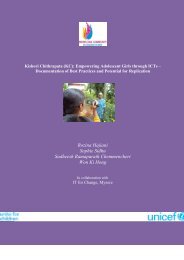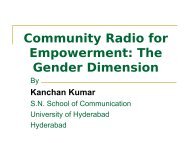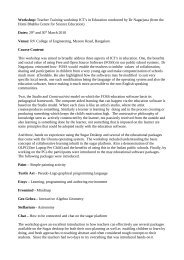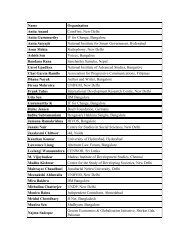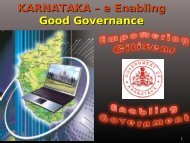IT for Change Case Study e-Choupal â An Initiative of ITC
IT for Change Case Study e-Choupal â An Initiative of ITC
IT for Change Case Study e-Choupal â An Initiative of ITC
Create successful ePaper yourself
Turn your PDF publications into a flip-book with our unique Google optimized e-Paper software.
<strong>IT</strong> <strong>for</strong> <strong>Change</strong> <strong>Case</strong> <strong>Study</strong><br />
e-<strong>Choupal</strong> – <strong>An</strong> <strong>Initiative</strong> <strong>of</strong> <strong>IT</strong>C<br />
This case study is part <strong>of</strong> a research project that sought to analyse how different telecentre models approach<br />
development on the ground, proceeding to elaborate a typology based on the cornerstones <strong>of</strong> participation<br />
and equity. To conduct this assessment, four telecentre projects were examined: the Gujarat government’s<br />
E-gram project, the corporate-led venture by <strong>IT</strong>C called e-<strong>Choupal</strong>, the private enterprise model <strong>of</strong> Drishtee,<br />
and the community-owned telecentres <strong>of</strong> the M.S. Swaminathan Research Foundation (MSSRF). Two main<br />
criteria were used in selecting the case studies – the diversity <strong>of</strong> ownership models, and the requirement <strong>of</strong><br />
a sufficient scale <strong>of</strong> the intervention. In addition to the field research conducted in 2008 using qualitative<br />
methods, the research also built on secondary sources.<br />
A review <strong>of</strong> the literature in the field <strong>of</strong> In<strong>for</strong>mation and Communication Technology <strong>for</strong> Development (ICTD)<br />
showed that while telecentres are viewed as contributing positively to development in general, they are largely<br />
not really seen as a space <strong>for</strong> catalysing trans<strong>for</strong>mative social change. Instead, there remains in the notion<br />
<strong>of</strong> telecentres <strong>for</strong> development a perpetuation <strong>of</strong> market-led approaches, wherein telecentres are viewed<br />
as a strategic means <strong>for</strong> expanding markets in rural areas, especially <strong>for</strong> corporates. In this approach, poor<br />
communities are repositioned as an opportunity <strong>for</strong> business, with ICTs as the most effective way <strong>of</strong> connecting<br />
them to the global market system. This espouses a version <strong>of</strong> inclusion that instumentalises disadvantaged<br />
sections, overlooking the potential <strong>of</strong> telecentres to serve as a tool <strong>for</strong> equitable and participatory development.<br />
Such subjugation <strong>of</strong> local development and the local community to the neo-liberal ideology can be seen as the<br />
‘Walmartisation’ or ‘marketisation’ <strong>of</strong> development (Gurstein, 2007:6). 1<br />
A critical question <strong>for</strong> telecentre related policies and programmes there<strong>for</strong>e examines how ICTs can trigger<br />
structural-institutional changes that promote overall human development, going beyond exclusive market<br />
frameworks. Based on a critical analysis <strong>of</strong> findings from the field, the research attempted to examine two<br />
hypotheses. The first relates to the need <strong>for</strong> the communitisation <strong>of</strong> ICTD, as is a strong move towards<br />
communisation in other areas <strong>of</strong> development, like health, livelihoods, education, etc. Second, the development<br />
<strong>of</strong> an ICT governance regime favouring an open, inclusive and participatory socio-technical architecture. The<br />
latter seeks to empower the peripheries, acting against the strong tendency towards centralisation <strong>of</strong> power<br />
<strong>of</strong> the unregulated use <strong>of</strong> ICTs.<br />
The following analysis <strong>of</strong> the e-<strong>Choupal</strong> project <strong>of</strong> <strong>IT</strong>C will be situated within this larger debate. 2<br />
<strong>IT</strong> <strong>for</strong> <strong>Change</strong><br />
2008<br />
I. Background<br />
and approach to<br />
development<br />
E-<strong>Choupal</strong> is an initiative <strong>of</strong> the<br />
International Business Division<br />
(IBD) <strong>of</strong> one <strong>of</strong> India’s leading<br />
private companies, <strong>IT</strong>C Ltd.<br />
Beginning in 2000, <strong>IT</strong>C set up a<br />
network <strong>of</strong> ICT kiosks around<br />
the country, called e-<strong>Choupal</strong> (an<br />
open meeting place in a village).<br />
According to Sachin Sahay,<br />
General Manager at IBD, the aim<br />
was to ‘build an intelligent first<br />
mile and a low cost last mile<br />
<strong>for</strong> agricultural products and<br />
services’. ICTs are the primary<br />
means <strong>of</strong> operationalising this<br />
vision. Every e-<strong>Choupal</strong> centre<br />
is equipped with a computer,<br />
Internet connectivity through<br />
satellite technology and solar<br />
power. In addition, it provides<br />
access to a web portal with<br />
current agriculture commodity<br />
prices at the village level<br />
<strong>for</strong> produce transactions.<br />
Additionally, e-<strong>Choupal</strong> supports<br />
best practices in farming<br />
through training sessions,<br />
provides in<strong>for</strong>mation on weather<br />
conditions, and supplies quality<br />
agricultural inputs like seeds and<br />
fertilisers. E-choupal centres<br />
<strong>for</strong>m part <strong>of</strong> IBD’s re-engineered
<strong>IT</strong> <strong>for</strong> <strong>Change</strong> <strong>Case</strong> <strong>Study</strong>, e-<strong>Choupal</strong> – <strong>An</strong> <strong>Initiative</strong> <strong>of</strong> <strong>IT</strong>C<br />
sourcing network, assuring<br />
supply <strong>for</strong> the company while<br />
cutting costs through improving<br />
the efficiency <strong>of</strong> the procurement<br />
value chain, which also results<br />
in better margins <strong>for</strong> the farmer.<br />
Apart from buying agricultural<br />
produce, other services,<br />
including in<strong>for</strong>mational services,<br />
are provided with the help <strong>of</strong> this<br />
ICT backbone.<br />
With an overall vision to improve<br />
the quality <strong>of</strong> life in rural<br />
India through a market-led<br />
business model, the e-<strong>Choupal</strong><br />
programme aims to enhance the<br />
returns on agriculture through<br />
the dual strategy <strong>of</strong> ICT-led<br />
improvements in production and<br />
procurement efficiencies. This<br />
is expected to in turn trigger a<br />
virtuous cycle <strong>of</strong> higher incomes,<br />
enlarged capacity <strong>for</strong> farmer risk<br />
management, larger investments<br />
and higher output quality.<br />
A strong focus on increasing<br />
rural incomes through ICTled<br />
procurement is positioned<br />
as a way to unleash the latent<br />
demand <strong>for</strong> industrial and retail<br />
goods <strong>for</strong> fuelling the continued<br />
growth <strong>of</strong> the Indian economy.<br />
The economic development<br />
perspective lends weight <strong>for</strong><br />
the creation <strong>of</strong> an ecology <strong>of</strong><br />
strategic rural markets, where<br />
products and services are<br />
especially targeted towards<br />
improving agricultural valuechains.<br />
Additionally, fast moving<br />
consumer goods (FMCGs),<br />
banking and insurance services<br />
are routed through the <strong>IT</strong>C<br />
channel, while quality retail<br />
products are provided at<br />
af<strong>for</strong>dable prices with an accent<br />
on brand building. Through<br />
e-<strong>Choupal</strong>, procurement hubs<br />
and <strong>Choupal</strong> Sagars (a kind <strong>of</strong><br />
rural supermarket), in<strong>for</strong>mation<br />
and products in urban centres<br />
are made available at the rural<br />
level, thus reducing travel and<br />
time investments <strong>for</strong> rural<br />
populations. E-<strong>Choupal</strong> there<strong>for</strong>e<br />
seeks to leverage ICTs to<br />
integrate rural areas into large<br />
corporate markets, and thus<br />
hopes to improve earnings as<br />
well as both the quantity and<br />
quality <strong>of</strong> consumption in rural<br />
areas.<br />
II. Implementation<br />
model and actors<br />
The e-<strong>Choupal</strong> model is<br />
positioned as an alternative<br />
to traditional modes <strong>of</strong><br />
procurement where farmers<br />
travel to the government market<br />
(or mandi) to sell their produce.<br />
<strong>IT</strong>C provides infrastructure and<br />
connectivity at the e-<strong>Choupal</strong><br />
centres, each <strong>of</strong> which services<br />
4-5 villages. At the centre,<br />
farmers can access a web portal<br />
with current market rates from<br />
a wide range <strong>of</strong> procurement<br />
centres, including mandis and<br />
<strong>IT</strong>C procurement hubs. <strong>An</strong> <strong>IT</strong>C<br />
procurement hub is set up <strong>for</strong><br />
every 20-30 km radius, servicing<br />
about 30-40 centres. Farmers<br />
use the services <strong>of</strong> the sanchalak<br />
(the centre operator) to find<br />
the price their produce can<br />
fetch at different places, via the<br />
computer. Using this in<strong>for</strong>mation,<br />
they are ‘empowered’ to make an<br />
in<strong>for</strong>med decision on when and<br />
at which procurement centre to<br />
sell their produce <strong>for</strong> maximum<br />
pr<strong>of</strong>it. Through in<strong>for</strong>mation<br />
accessed at the e-<strong>Choupal</strong>,<br />
farmers can choose to travel to<br />
the <strong>IT</strong>C hub to sell their produce<br />
at rates that are fixed with a<br />
flooring <strong>for</strong> any given day but<br />
which may increase because<br />
<strong>of</strong> the company’s policy <strong>of</strong> no<br />
ceilings on rates. The sanchalak<br />
gets a fixed commission set<br />
by <strong>IT</strong>C <strong>for</strong> every transaction<br />
from his village that is realised<br />
through the <strong>IT</strong>C procurement<br />
hub. The establishment <strong>of</strong><br />
the procurement hub has<br />
enabled the company to cease<br />
procurement activities at<br />
government mandis.<br />
<strong>IT</strong>C also initiated the <strong>Choupal</strong><br />
Pradarshan Kheth (<strong>Choupal</strong><br />
Demonstration Field) programme<br />
to improve yields with a<br />
demonstration plot <strong>of</strong> land <strong>for</strong><br />
every village cluster. Accepted<br />
best practices have been put<br />
into practice along with high<br />
quality fertilisers and seeds, and<br />
comparisons made with yields<br />
from control plots to encourage<br />
farmers to switch to improved<br />
farming inputs and methods.<br />
This programme is one aspect <strong>of</strong><br />
<strong>IT</strong>C’s commitment to improved<br />
agricultural yield, and is<br />
supplemented by the provision <strong>of</strong><br />
high quality seeds and fertilisers,<br />
both at the e-<strong>Choupal</strong> and at<br />
the <strong>IT</strong>C rural retail centre, the<br />
<strong>Choupal</strong> Sagar (CS).<br />
CS provides the third spoke<br />
in <strong>IT</strong>C’s procurement and<br />
productivity improvement<br />
strategy along with e-<strong>Choupal</strong><br />
and the procurement hub.<br />
Modelled as a one-stop retail<br />
supermarket experience <strong>for</strong><br />
rural customers, it is set up<br />
in locations that lie within 30<br />
kilometres <strong>of</strong> any e-<strong>Choupal</strong><br />
village. It thus doubles up<br />
as a hub with an electronic<br />
weighbridge <strong>for</strong> produce, fuel<br />
pumps, and a sale point <strong>for</strong> heavy<br />
2
<strong>IT</strong> <strong>for</strong> <strong>Change</strong> <strong>Case</strong> <strong>Study</strong>, e-<strong>Choupal</strong> – <strong>An</strong> <strong>Initiative</strong> <strong>of</strong> <strong>IT</strong>C<br />
duty consumer goods and FMCGs.<br />
Additionally, the CS conducts<br />
training sessions <strong>for</strong> agriculture<br />
related practices and has tie-ups<br />
with private hospitals to provide<br />
check-ups at a nominal fee. CSs<br />
are beginning to branch into<br />
banking, insurance and pharmacy<br />
related services, and are<br />
conceptualised as a part <strong>of</strong> <strong>IT</strong>C’s<br />
strategy to build a collaborative<br />
‘Pan-Indian Network <strong>of</strong><br />
Companies’ that service the<br />
untapped rural markets through<br />
the single <strong>IT</strong>C channel.<br />
E-<strong>Choupal</strong> centres are managed<br />
by a sanchalak selected from the<br />
village. <strong>IT</strong>C stipulates farmers<br />
with mid-sized (about 25 acres)<br />
land holdings <strong>for</strong> sanchalak<br />
selection, and insist that they have<br />
a proven record <strong>of</strong> community<br />
involvement. Actual selection<br />
is managed by <strong>IT</strong>C through<br />
consultations with the panchayat, 3<br />
and is <strong>for</strong>malised through a<br />
public oath-taking ceremony. <strong>IT</strong>C<br />
conducts initial computer literacy<br />
training <strong>for</strong> the sanchalak and<br />
organises free long-term technical<br />
support. In addition to their work<br />
on the computer, sanchalaks are<br />
encouraged to stock and sell<br />
FMCGs provided by <strong>IT</strong>C and are<br />
trained in basic marketing and<br />
accounting skills.<br />
<strong>An</strong> upsanchalak serves as a link<br />
between the e-<strong>Choupal</strong> village<br />
and surrounding villages. The<br />
upsanchalak communicates daily<br />
prices received from the sanchalak<br />
to farmers in his village. This<br />
further reduces the time spent<br />
on finding agricultural prices by<br />
farmers in non-e-<strong>Choupal</strong> villages.<br />
The sanchalaks and upsanchalaks<br />
negotiate a sharing <strong>of</strong> the <strong>IT</strong>C<br />
commission amongst themselves.<br />
In addition, <strong>IT</strong>C has engaged<br />
salaried employees, sanyojaks,<br />
who along with a small staff<br />
manage the hub where farmers<br />
come to sell their produce.<br />
ICTs enable effective control by<br />
the company <strong>of</strong> all processes<br />
in the procurement chain, right<br />
from price setting and daily<br />
procurement volumes, to the<br />
monitoring <strong>of</strong> payments to<br />
farmers, and commissions and<br />
target setting <strong>for</strong> sanchalaks<br />
and hubs. These decisions are<br />
taken after careful analysis<br />
keeping the overall pr<strong>of</strong>itability<br />
<strong>of</strong> <strong>IT</strong>C in consideration. The<br />
front-end <strong>of</strong> the whole system is<br />
the e-<strong>Choupal</strong> centre, where the<br />
whole village can be introduced<br />
into the <strong>IT</strong>C procurement and<br />
retail channel.<br />
In this process, <strong>IT</strong>C more or<br />
less monopolises agricultural<br />
procurement in the areas that<br />
it operates in. Increasingly, it<br />
also monopolises channels <strong>of</strong><br />
agriculture related in<strong>for</strong>mation<br />
and products, as well as the<br />
rural market <strong>for</strong> many other<br />
services and products, from<br />
insurance to bakery products.<br />
This reflects their business vision<br />
as a company. To what extent this<br />
business approach correlates<br />
with their rural development<br />
goals is a question <strong>for</strong> analysis<br />
and independent judgement.<br />
Development impact<br />
– Is a complete<br />
corporate-community<br />
win-win possible?<br />
How long will a monopoly<br />
sustain consumer advantage<br />
Even if one were to go by the<br />
logic that markets themselves<br />
can ensure development, it<br />
would not stand to market logic<br />
that a corporate amassing<br />
a monopoly, as is <strong>IT</strong>C’s<br />
business model, could sustain<br />
the interests <strong>of</strong> consumers<br />
<strong>for</strong> long. Moreover, <strong>IT</strong>C’s<br />
business model extends<br />
to monopolising channels<br />
<strong>of</strong> in<strong>for</strong>mation. It provides<br />
market prices in different<br />
mandis, procures the produce,<br />
<strong>of</strong>fers in<strong>for</strong>mation about best<br />
agriculture practices and<br />
provides agricultural inputs,<br />
like seeds and fertilisers.<br />
Simple economic logic tells us<br />
that the apparent consumer<br />
benefits accrued when a<br />
monopoly is being established<br />
is short lived. In addition,<br />
such an approach staves <strong>of</strong>f<br />
alternative avenues, such as<br />
freelance government mandi<br />
based procurement agents who<br />
are folding up their business in<br />
areas where <strong>IT</strong>C operates. It<br />
is highly questionable whether<br />
these monopolies, and the<br />
totalising potential that ICTs<br />
contain, can be beneficial <strong>for</strong><br />
the community.<br />
Is the market enough to serve<br />
a community’s development<br />
priorities and interests?<br />
The e-<strong>Choupal</strong> system is built<br />
around the needs and interests<br />
<strong>of</strong> rich farmers, with some<br />
spin-<strong>of</strong>f benefits <strong>for</strong> those with<br />
some degree <strong>of</strong> purchasing<br />
power. There is no pro<strong>of</strong> that<br />
the trickle-down benefit <strong>of</strong><br />
an improved local agriculture<br />
economy will reach the weaker<br />
sections <strong>of</strong> the community.<br />
On the other hand, increased<br />
reliance on commercial crops<br />
can decrease local food security,<br />
3
<strong>IT</strong> <strong>for</strong> <strong>Change</strong> <strong>Case</strong> <strong>Study</strong>, e-<strong>Choupal</strong> – <strong>An</strong> <strong>Initiative</strong> <strong>of</strong> <strong>IT</strong>C<br />
both through reduced availability<br />
and increased prices. Increased<br />
re-orientation (and dependence)<br />
<strong>of</strong> the local economy on the<br />
e-<strong>Choupal</strong> system can have<br />
problematic mid to long term<br />
results, which needs to be<br />
carefully assessed, and not left<br />
to the involved corporate. This<br />
is crucial because the local<br />
community has neither any role<br />
nor much leverage to influence<br />
the emerging dominant system.<br />
With monopolistic control over<br />
an entire local agricultural<br />
ecology, e-<strong>Choupal</strong> represents<br />
a development model where<br />
a transnational corporation<br />
deploys a captive, unregulated<br />
ICT network that locks in<br />
a large number <strong>of</strong> farmers,<br />
crowding out the small and<br />
marginal land-holding farmers.<br />
It thus promotes corporate<br />
dependency <strong>of</strong> local agriculture<br />
and monoculturisation <strong>of</strong> agroproduction<br />
systems – issues that<br />
are in fact intrinsic to the choice<br />
<strong>of</strong> development model.<br />
Threat to public and<br />
community based systems<br />
The e-<strong>Choupal</strong> system not only<br />
serves as a monopoly agriculture<br />
produce procurement channel,<br />
but also a source <strong>of</strong> agriculture<br />
and development in<strong>for</strong>mation,<br />
agriculture extension services,<br />
and increasingly, community<br />
in<strong>for</strong>mation <strong>for</strong> upstream actors.<br />
It thus threatens to overwhelm<br />
public and community-based<br />
systems that traditionally<br />
undertook many <strong>of</strong> these<br />
activities. In fact, it is a real<br />
concern that, citing the presence<br />
<strong>of</strong> e-<strong>Choupal</strong> kind <strong>of</strong> corporate<br />
systems, many governments will<br />
begin to withdraw their presence<br />
in these areas. Consequently,<br />
this raises a number <strong>of</strong> equity<br />
and social justice based issues.<br />
There are some early indications<br />
that this may already be taking<br />
place. There is no leverage<br />
that the local community and<br />
local self-governance systems<br />
have over the e-<strong>Choupal</strong><br />
system, and during interviews,<br />
most e-<strong>Choupal</strong> actors spoke<br />
rather dismissively about such<br />
governance systems.<br />
While ICTs can and should<br />
be used to improve market<br />
efficiency in rural areas, it<br />
must be done in a manner that<br />
promotes competitive markets<br />
that valorise local enterprise and<br />
other local economic resources,<br />
rather than monopolistic<br />
corporate-dependent markets.<br />
At the same time, ICTs should<br />
also be used to strengthen rural<br />
activities that are best done by<br />
the public sector, rather than<br />
being employed to justify its<br />
withdrawal. Furthermore, ICT<br />
enabled empowerment <strong>of</strong> the<br />
local community will enable<br />
both their active and equal<br />
participation in the market<br />
as well as governance and<br />
development related activities.<br />
Telecentre models should<br />
address this imperative centrally<br />
through an engaged involvement<br />
<strong>of</strong> communities in running<br />
telecentres.<br />
Endnotes<br />
1 Gurstein M. (2008), ‘Towards a Critical Theory <strong>of</strong> Telecentres: In the<br />
Context <strong>of</strong> Community In<strong>for</strong>matics ‘, <strong>IT</strong> <strong>for</strong> <strong>Change</strong>: Bengaluru<br />
2 This case study is part <strong>of</strong> a broader research undertaking funded by<br />
the Social Science Research Council (SSRC), an independent nonpr<strong>of</strong>it<br />
organisation based in New York. The study was commissioned<br />
under the Collaborative Grants in Media and Communications:<br />
Necessary Knowledge <strong>for</strong> Democratic Public Sphere programme <strong>of</strong><br />
SSRC<br />
3 Panchayat is an administrative unit <strong>of</strong> the government at the village<br />
level<br />
Credits<br />
Coordination : Chloé Zollman<br />
Design<br />
: Varun Dhanda, Krupa Thimmaiah<br />
Research report : Roshni Neggehalli, Deepa Shankaran<br />
Research coordination : Parminder Jeet Singh, <strong>An</strong>ita Gurumurthy<br />
Editor<br />
: Parminder Jeet Singh, Deepika Khatri<br />
Editorial support : Krittika Vishwanath<br />
Printed by<br />
: National Printing Press, Bengaluru<br />
<strong>IT</strong> <strong>for</strong> <strong>Change</strong> is an India-based NGO working<br />
on in<strong>for</strong>mation society theory and practice<br />
from the standpoint <strong>of</strong> equity and social justice.<br />
Through our research, advocacy and field<br />
projects, we seek to challenge approaches that<br />
fail to address the structural exclusions in the<br />
emerging in<strong>for</strong>mation society. We also propose<br />
alternative models that are participatory<br />
and equitable. Our work spans a range <strong>of</strong><br />
development arenas - gender, education,<br />
community media and governance. <strong>IT</strong> <strong>for</strong><br />
<strong>Change</strong> is in Special Consultative Status with<br />
the Economic and Social Council <strong>of</strong> the United<br />
Nations.<br />
A detailed version <strong>of</strong> this case study can be requested from communications@<strong>IT</strong><strong>for</strong><strong>Change</strong>.net.<br />
Creative Common License: Attribution-NonCommercial-ShareAlike 3.0<br />
4


